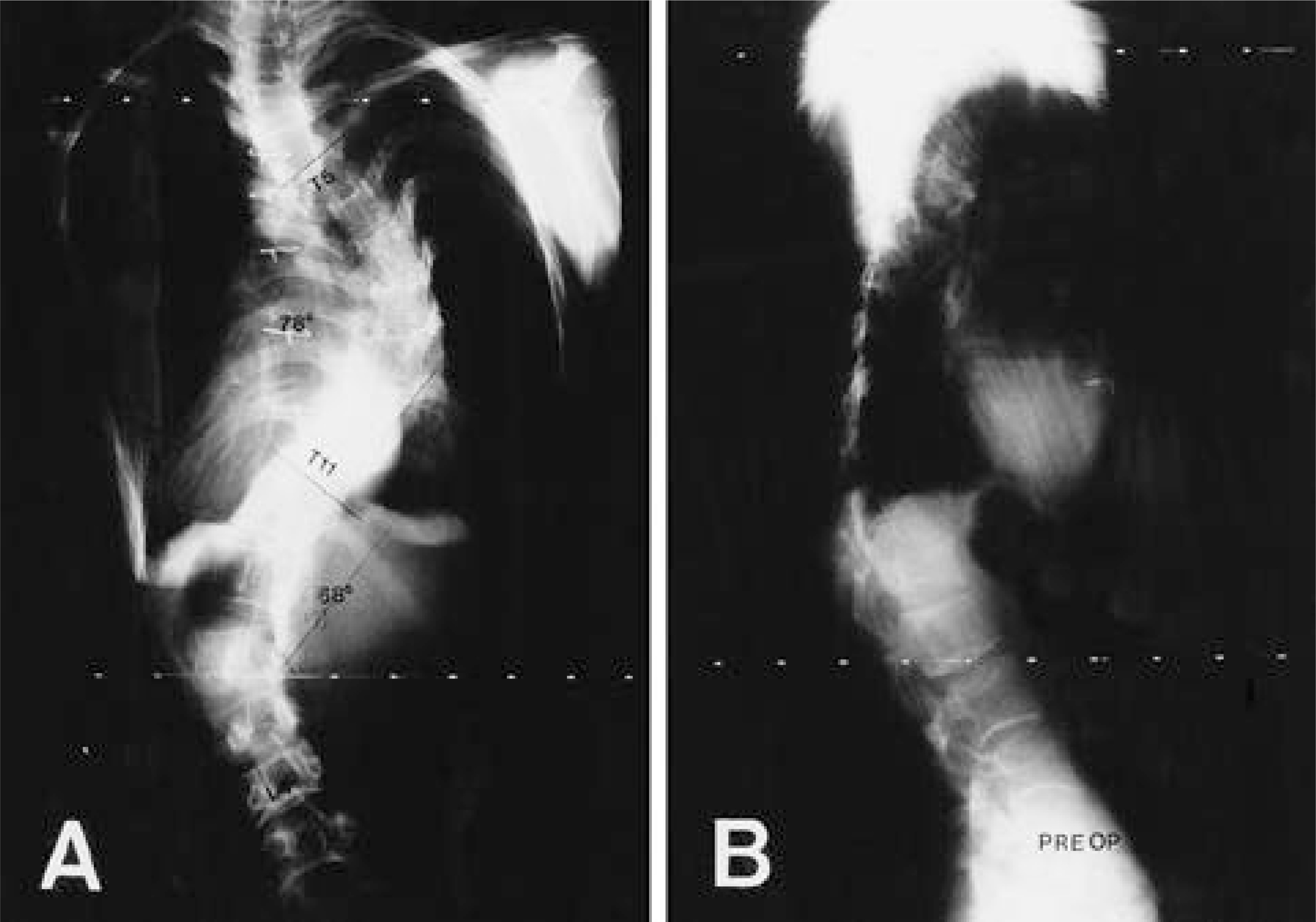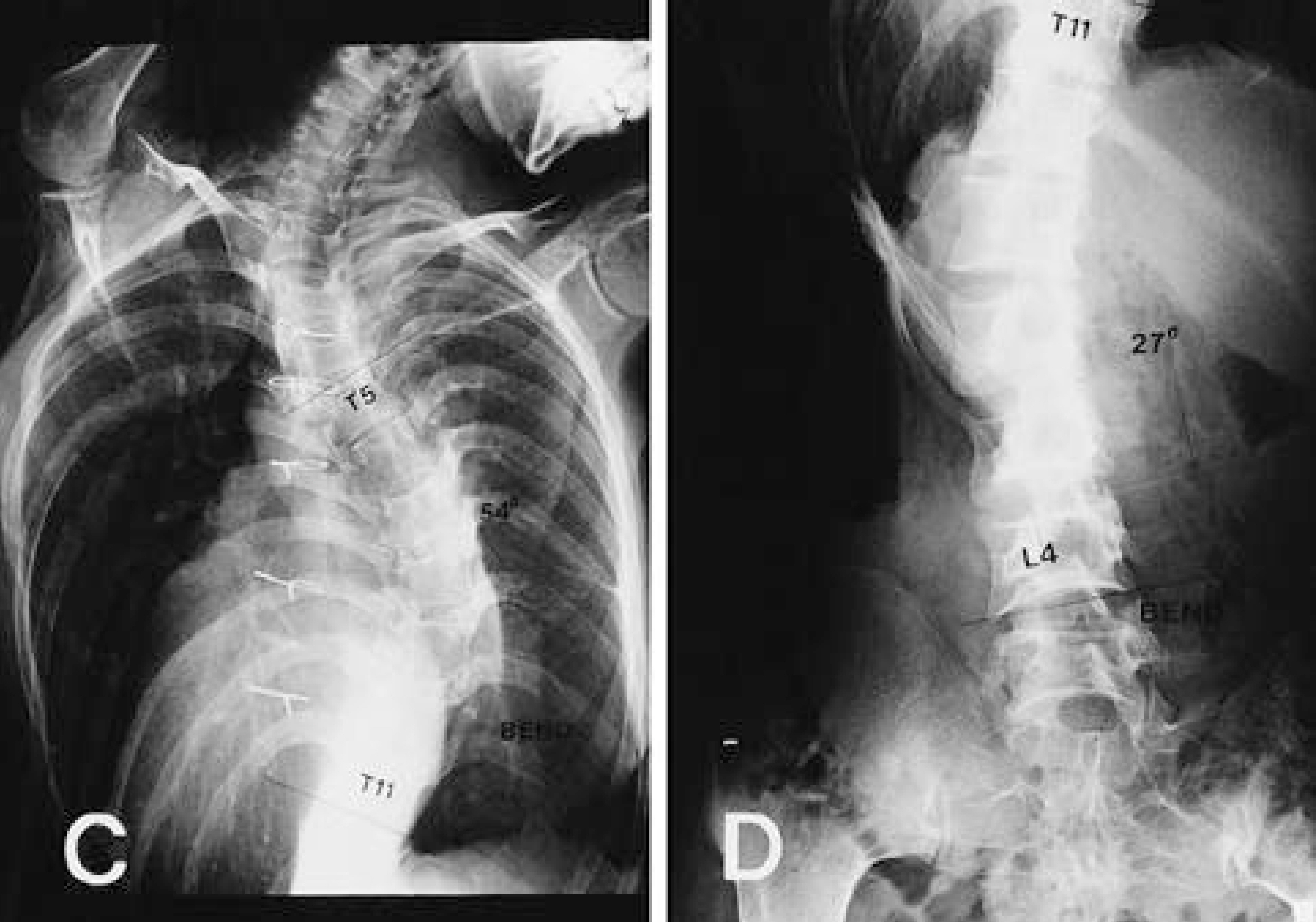J Korean Soc Spine Surg.
2001 Dec;8(4):482-490.
Scoliosis Associated with Marfan Syndrome
- Affiliations
-
- 1Department of Orthopedic Surgery, College of Medicine, Seoul National University, Seoul, Korea. choonki@plaza.snu.ac.kr
Abstract
OBJECTIVES
To evaluate characteristics and results of treatment of scoliosis associated with Marfan syndrome
METHODS
The clinical data of 57 patients diagnosed as Marfan syndrome from January 1989 to June 1999 were reviewed. Thirty one patients had major curves more than 10 degrees by Cobb's method on whole spine standing film and their curve patterns and treatment methods were analyzed. Twelve cases of Marfan scoliosis who underwent posterior instrumented fusion were compared with randomly-sampled cases with idiopathic scoliosis about flexibility, correctability and correction loss of curves.
RESULTS
Scoliosis was identified in 31 of 57 patients (54.4%) and among them 15 patients had the curve more than 40 degrees. Twelve curves were double major, 10 were thoracic, and 8 were double thoracic. Seventy-five per cent of the 57 patients had congenital heart disease and 40% had lens dislocation. Twelve of 31 cases underwent posterior fusion with pedicle screw instrumentation. Marfan scoliosis (mean flexibility; 39% in thoracic, 52% in lumbar) were significantly less flexible than idiopathic scoliosis (60% in thoracic, 93% in lumbar) (P<0.05). Mean correctability of Marfan scolisis of operation (61% in thoracic, 55% in lumbar) was poorer than that of idiopathic scoliosis (72% in thoracic, 67% in lumbar), however, this was not significant statistically (P>0.05). Mean correction loss in Marfan syndrome was 3.2% at the mean 4.1 year follow-up in 9 cases.
CONCLUSIONS
The prevalence of scoliosis in Marfan syndrome shows positive correlation with severity of the disease. As compared to idiopathic scoliosis, the curve associated with Marfan syndrome was larger and less flexible. After posterior fusion using pedicle screw instrumentation, the correctability of Marfan curve was poorer than that of idiopathic curve, which is, however, insignificant statistically. So it was considered to be a good method to treat Marfan scoliosis.
Keyword
MeSH Terms
Figure
Reference
-
1). Birch JG, Herring JA. Spinal deformity in Marfan syndrome, J Pediatr Orthop. 7:546–552. 1987.2). Brenton DP, Dow CJ, Hay RL and Wynne-Davies. Ho-mocystinuria and Marfan syndrome. J Bone Joint Surg. 54-B:277–283. 1972.3). Dietz HC, Cutting GR, Pyeritz RE, Maslen CL, Sakai LY, Corson GM, Puffenberger EG, Nathakuma EJ, Cur-ristin SM, Mayers DA, Fracomano CA. Marfan syndrome caused by a recurrent de novo missense mutation in the fibrillin gene, Nature. 352(25):337–339. 1991.4). Donaldson DH, Brown CW. Marfan's spinal pathol -ogy, The textbook of spinal surgery. 2nd Edition. Philadelphia: Lippincott Raven Publishers;p. 299–306. 1997.5). Joseph KN, Kane HA, Milner RS, Steg NL, Williamson MB, Bowen JR. Orthopedic aspects of the Marfan phenotype, Clin Orthop. 277:251–261. 1992.6). Lee CS, Chung SS, Lee SG, Son HS, Kim SM. Spinal abnormalities associated with Marfan syndrome J Korean Spine Surg. 7:365–372. 2000.7). Lonstein JE, Carlson JM. The prediction of curve progression in untreated idiopathic scolisis during growth, J Bong Joint Surg. 66-A:1061–1071. 1984.8). Makin M, MacEwen GE, Steel HH. Marfan syndrome and its marfanoid variant, J West Pac Orthop Assoc. 21:29–36. 1984.9). Orcutt FV, DeWald RL. The special problems which the Marfan syndrome introduces to scoliosis, J Bone Joint Surg. 56-A:1763–1768. 1974.10). Pyeritz RE, McKusick VA. The Marfan syndrome: dignosis and management, N Engl J Med. 305:772–777. 1979.11). Robins PR, Moe JH, Winter RB. Scoliosis in Marfan syndrome, J Bone Joint Surg. 57-A:358–368. 1975.12). Sponseller PD, Hobbs W, Riler LH, Pyeritz RE. The thoracolumbar spine in Marfan syndrome, J Bone Joint Surg. 77-A:867–876. 1995.13). Sponseller PD, Sethi N, Cameron DE, Pyeritz RE. Infantile scoliosis in Marfan syndrome, spine. 22:509–516. 1997.14). Streeten EA, Murphy EA, Pyeritz RE. Pulmonary function in the Marfan syndrome, Chest. 91(3):408–412. 1987.15). Suk SI, Ahn JW, Kim IK, Choi IH. The Incidence of Scoliosis in Korea Part III: The Incidence of Scoliosis in the Middle and High School Students. J Korean Orthop Assoc. 15:1–6. 1980.
Article16). Suk SI, Kim JH, Kim WJ, Kim DS, Lee SM, Kim JH. The Influence of Segmental Pedicle Screw Fixation on Distal Fusion Level in King Type 1 Adolescent Idiopathic Scoliosis. J Korean Spine Surg. 4:273–280. 1997.17). Suk SI, Lee CK, Kim WJ, Chung YJ, Song KY, Park YB. Segmental pedicle screw fixation in the treatment of Thoracic idiopathic scoliosis. J Korean Orthop Assoc. 30:49–58. 1995.
Article18). Taneja DK, Manning CW. Scoliosis in Marfan syndrome and arachnodactyly. Zorab PA, editor. ed.scoiosis. London: Academic press;p. 261–281. 1977.19). Weistein SL. The Pediatric Spine, Principles and Prac -tice. New York: Ravin Press;p. 665–683. 1994.20). Winter RB. Thoracic lordoscoliosis in Marfan syndrome: Report of two patients with surgical correction using rods and sublaminar wires, spine. 15(3):233–235. 1990.21). Winter RB. The surgical treatment of scoliosis in Marfan syndrome. Zobra PA, editor. ed.Scoliosis. London: Academic press;p. 238–299. 1977.




